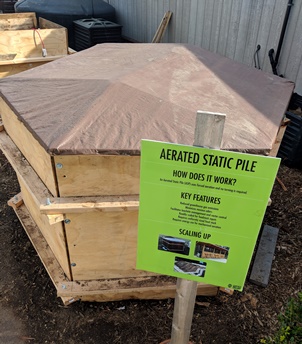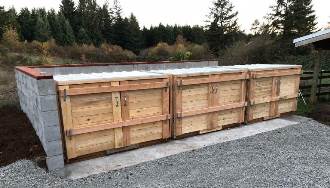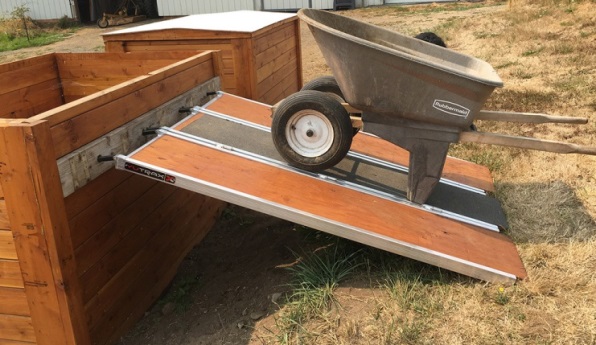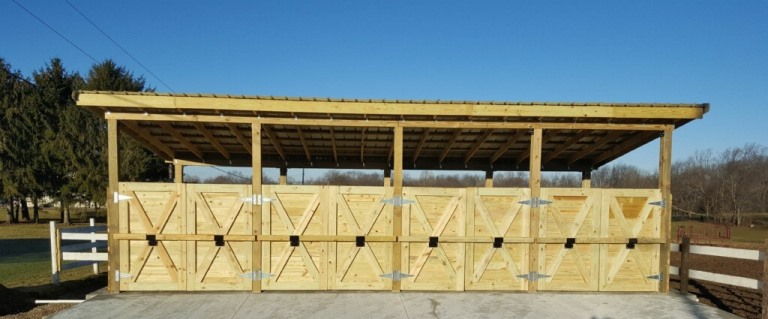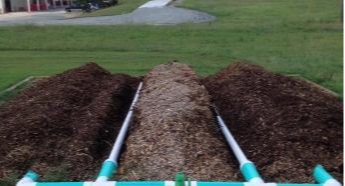| Aerated Compost Systems |
The Gift that Keeps on Giving
What's NewBook it, Danno! We have added a new appointment booking feature to the Contact Us page on our website. Now visitors can quickly and easily take the next step, eliminating a back-and-forth email exchange with the same goal in mind. If you are ready to take the next step to find out if an O2Compost system is the answer you've been looking for, use our booking app to pick the day and time that works best for a FREE 30-minute personal consultation with Peter Moon. During your conversation with Peter, he will learn more about your farm/facility, ask about your goals, answer any questions you might have about composting and, if requested, he will provide you with a proposal and cost estimate. The original Contact Us Form is also still available for you to complete and submit. Peter will respond to new contact emails at his earliest opportunity.
Winter CompostingFor those who live in the northern latitudes, cold winter weather can pose many challenges with your O2Compost system.
If You Already Own an O2Compost System, I Recommend that You Do the Following:
If You Are Considering an O2Compost System
“Think BIG, Start Small” with an O2Compost Micro-Bin System
Take Action When It’s Snowing Outside
Volunteers Compost Food Waste in San Diego CountyOver the years, our compost systems have been used in a variety of educational and community applications. It’s a good feeling to know the idea of aerated composting is being embraced, taught, and shared with others. Here is a latest success story: The Solana Center for Environmental Innovation is a nonprofit organization in San Diego County that focuses on organic waste reduction, becoming one of the first community-based recycling programs in the State of California in 1983. In 2017, the Center’s Director of Education, Diane Hazard, spearheaded the installation of the first of many O2Compost Micro-Bin Systems. Two of the completed bins are shown below.
The O2Compost Micro-Bins are used to compost food waste brought in by participants of the Food Cycle Program, including bokashi treated food waste (fermented organic matter – www.bokashiliving.com), coffee grounds, wood chips, finished compost, and paper towels. As an added bonus, the participants of the program are allowed to pick up the finished compost for use in their home gardens. According to the Center’s Environmental Educator, Tori Morin, the Food Cycle program is growing rapidly. Since the installation of the first aerated compost bin, Solana Center’s composting programs have diverted nearly 6 million pounds of organic waste from the landfill. Last year alone, Solana Center accomplished the following:
Congratulations to Diane, Tori and the many Solana Center staff and volunteers who have made this organization such a success! Please visit their website for more information about the services they provide.
Frequently Asked QuestionQUESTION: What is composting? ANSWER: "Composting means the biological degradation and transformation of organic solid waste under controlled conditions designed to promote aerobic decomposition." “Natural decay of organic solid waste under uncontrolled conditions is not composting.” Reference: Washington State Solid Waste Handling Standards: WAC 173-350-100 Good News Composting does not require advanced training in engineering or biology. In fact, composting is easy if you achieve a few simple parameters when preparing the compost mix. These include:
At this point all we need to do is induce airflow through the pile. We accomplish this with a small blower that is operated by an on/off cycle timer. For an O2Compost bin system, the timer is typically set to turn on for 30-seconds and off for 30-minutes to get the process started. The Active Phase of Composting With aeration, the initial, or Active Phase, of composting occurs in the first 21 to 30 days. During this period, the temperature of the compost mix will increase rapidly and our goal is to achieve temperatures throughout the pile of 55oC (= 131oF) for at least 3 days. When we do this, we effectively destroy pathogens, parasites, fly larvae, and weed seeds in the mix. The Active Phase of composting is largely a bacterial driven process, and these bacteria represent a range of organisms that thrive at low, medium and high temperatures. The bacteria consume the readily available forms of carbon including: carbohydrates; proteins; simple sugars; and fats, oils and grease (FOG). When we add a small amount of air to the mix, the pile temperature will go up but if the pile temperatures exceed 70oC (=158oF) the composting process slows down. When this occurs, we increase the blower on-time to displace the excess heat out of the pile (observed as steam) and the pile temperature slowly drops back into the desired range. The Curing Phase of Composting After about 21 days of Active Composting, the bacteria in the compost pile are replaced by a wide range of fungi, as evidenced by mushrooms, mycelium (photo) and a white fibrous material called Actinomycetes (“Ac-tin-oh-my-seats”). It is the fungi that give compost it’s “forest-duff” fragrance. During the Curing Phase, the fungi breakdown the more resilient forms of carbon including: cellulose and hemi-cellulose (hay); and lignin (wood fiber). It is during the Curing Phase that we also see most of the textural change in the finished compost product. It is also during this phase that unstable (ammonium) forms of nitrogen convert over to stable (nitrate) forms of nitrogen which are available to augment plant growth for long periods of time. Curing can take place in the compost bin without airflow or in a pile off to the side of the compost system. This phase of the composting process generally takes 30-60 days when the compost is to be used in the garden or sold or given away to friends and neighbors. Vermi-Composting If the compost is removed from the aerated bin and placed on the ground to cure, earth worms will find it and populate the pile over a period of several months. And earthworms make excellent finished compost. In fact, many of O2Compost’s clients are vermi-composters who are in the business of raising worms and producing worm castings, which have truly magical powers in the garden. More Good News With an O2Compost System you will:
To learn more, visit Compost 101 on our website. New Systems Come Online
|
|
O2Compost Price-Moon Enterprises, Inc. PO Box 1026 Snohomish, WA 98291 

info@o2compost.com o2compost.com 360.568.8085 |



